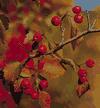- hawthorn
-
—hawthorny, adj./haw"thawrn'/, n.any of numerous plants belonging to the genus Crataegus, of the rose family, typically a small tree with stiff thorns, certain North American species of which have white or pink blossoms and bright-colored fruits and are cultivated in hedges.[bef. 900; ME; OE haguthorn, c. MD hagedorn, MHG hagendorn, ON hagthorn. See HAW3, THORN]
* * *
Any of various thorny shrubs or small trees of the genus Crataegus, in the rose family, native to the northern temperate zone.Many species are native to North America. The simple leaves are usually toothed or lobed. Hawthorns bear white or pink flowers, usually in clusters, and small applelike, red (rarely blue or black) fruits. Many cultivated varieties are grown as ornamentals for their attractive flowers and fruits. The hawthorn is well suited for hedgerows; its combination of sturdy twigs, hard wood, and many thorns makes it a formidable barrier to cattle and hogs. Hawthorn (Crataegus)Walter Chandoha
Hawthorn (Crataegus)Walter Chandoha* * *
▪ plantany of a number of thorny shrubs or small trees of the genus Crataegus, in the rose family (Rosaceae), native to the North Temperate Zone. Many species are native to North America. The hawthorn's leaves are simple, and usually toothed or lobed. The white or pink flowers, usually in clusters, are followed by small applelike, red fruits, or more rarely by blue or black ones. Many cultivated varieties of hawthorn are grown as ornamentals for their attractive flowers and fruits. Some species are characterized by horizontal branching, a growth habit considered to enhance their ornamental value.The hawthorn is well-suited to form hedges, and its combination of sturdy twigs, hard wood, and many thorns makes it a formidable barrier to cattle and hogs. It is seldom used for this purpose in North America, however. Two haws that make ideal hedges are the English midland hawthorn (C. oxyacantha, or C. laevigata) and the common hawthorn (C. monogyna), the latter growing to 9 m (30 feet) in height. C. laevigata has given rise to several cultivated varieties with showier flower clusters, in pink and red; unfortunately the species and its varieties often suffer from leaf spot, fire blight, and cedar-hawthorn rusts, which cause early defoliation and decline.A most strikingly thorned American species is the cockspur hawthorn (C. crus-galli), with extremely long, slender spines up to 8 cm (3 inches) long; a thornless variety is also available. The Washington hawthorn (C. phaenopyrum, or C. cordata) is famous for its red autumn colour and its abundant clusters of orange-red fruits that persist on the twigs well into winter; it is somewhat susceptible to rust but is otherwise a durable and much-used ornamental. Downy, or red, haw (C. mollis) has whitish hairs on young twigs and downy leaves. Lavalle hawthorn (C. × lavallei) is a compact vase-shaped tree with dense glossy foliage.Numerous wild species of hawthorn provide thickets in the eastern half of the United States, including green (C. viridis), May (C. opaca), Allegheny (C. intricata), dotted (C. punctata), and fleshy (C. succulenta) hawthorns.* * *
Universalium. 2010.
